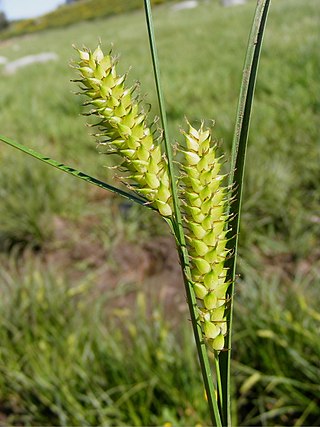
The Cyperaceae are a family of graminoid (grass-like), monocotyledonous flowering plants known as sedges. The family is large, with some 5,500 known species described in about 90 genera, the largest being the "true sedges" genus Carex with over 2,000 species.

Carex is a vast genus of nearly 2,000 species of grass-like plants in the family Cyperaceae, commonly known as sedges. Other members of the family Cyperaceae are also called sedges, however those of genus Carex may be called true sedges, and it is the most species-rich genus in the family. The study of Carex is known as caricology.

Uncinia is a genus of flowering plants in the family Cyperaceae, known as hook-sedges in Australia and as hook grasses or bastard grasses in New Zealand. The genus is characterised by the presence of a long hook formed by an extension of the rachilla, which is used to attach the fruit to passing animals (epizoochory), especially birds, and it is this feature which gives the genus its name, from the Latin uncinus, meaning a hook or barb.

Pedicularis groenlandica is a showy flowering plant in the family Orobanchaceae commonly known as elephant's head, little pink elephant, elephantella, or similar common names inspired by the resemblance of the flower to the head of an elephant. It is also less commonly known as butterfly tongue for the long beak on the flower. Like many other plants in genus Pedicularis, it is a parasitic plant and depends on host plants to survive.

Carex vesicaria is an essentially Holarctic species of sedge known as bladder sedge, inflated sedge, and blister sedge. It has been used to insulate footwear in Norway and among the Sami people, and for basketry in North America.
Guzmania bracteosa is a plant species of flowering plant in the Bromeliaceae family. It is endemic to Ecuador.

Carex capillacea, common name yellowleaf sedge in Tasmania, is a species of sedge found in Assam, the far east of Russia, New Guinea, south east Australia, New Zealand, Malesia, China, Japan and India.

Carex viridula, known as little green sedge, green sedge, or greenish sedge, is a small flowering plant native to North America, Europe, Asia, and Morocco.

Carex baldensis is a species of sedge. Its native range is the Alps.

Carex bohemica is a species of sedge, native to Europe, Siberia, and northern Asia to Japan, and it was introduced to Sweden. It prefers to grow in mud flats. It is called Zypergras-Segge in German.
Carex bonplandii, Bonpland's sedge, is a tussock-forming species of perennial sedge in the family Cyperaceae. It is native to southern parts of Mexico, parts of Central America and northern parts of South America.

Carex angustisquama is a tussock-forming species of perennial sedge in the family Cyperaceae. It is native to northern parts of Honshu in Japan.
Carex bodinieri is a tussock-forming species of perennial sedge in the family Cyperaceae. It is native to Japan and eastern parts of China.

Carex curvicollis is a tussock-forming species of perennial sedge in the family Cyperaceae. It is native to parts of Japan.
Carex capilliformis is a tussock-forming species of perennial sedge in the family Cyperaceae. It is native to central parts of China.
Carex davidii is a tussock-forming species of perennial sedge in the family Cyperaceae. It is native to parts of China.
Carex delavayi is a tussock-forming species of perennial sedge in the family Cyperaceae. It is native to parts of south central China.

Carex dissitiflora is a tussock-forming species of perennial sedge in the family Cyperaceae. It is native to parts of Japan and Taiwan.
Carex drepanorhyncha is a tussock-forming species of perennial sedge in the family Cyperaceae. It is native to South-Central China. It has three common names, which are, Drepanorhyncha Sedge, Drepanorhyncha Fox Sedge, and Drepanorhyncha Wood Sedge. It also has a Chinese common name of 镰喙薹草, or lián huì tái cǎo, meaning sicklebill.

Palisota bracteosa is a species of plant in the family Commelinaceae. It is native to western Africa, specifically Cameroon, Equatorial Guinea, Gabon, Ghana, Guinea, Gulf of Guinea islands, Ivory Coast, Liberia, Nigeria, Sierra Leone, and Togo.













